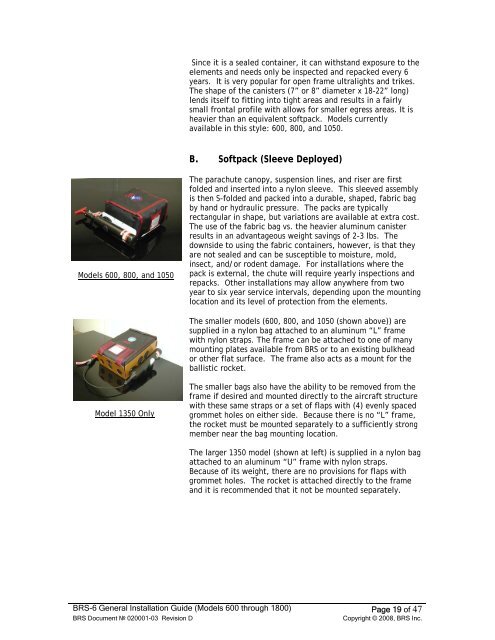BRS-6 General Installation Guide - CAFE Foundation
BRS-6 General Installation Guide - CAFE Foundation
BRS-6 General Installation Guide - CAFE Foundation
You also want an ePaper? Increase the reach of your titles
YUMPU automatically turns print PDFs into web optimized ePapers that Google loves.
Models 600, 800, and 1050<br />
Model 1350 Only<br />
Since it is a sealed container, it can withstand exposure to the<br />
elements and needs only be inspected and repacked every 6<br />
years. It is very popular for open frame ultralights and trikes.<br />
The shape of the canisters (7” or 8” diameter x 18-22” long)<br />
lends itself to fitting into tight areas and results in a fairly<br />
small frontal profile with allows for smaller egress areas. It is<br />
heavier than an equivalent softpack. Models currently<br />
available in this style: 600, 800, and 1050.<br />
B. Softpack (Sleeve Deployed)<br />
The parachute canopy, suspension lines, and riser are first<br />
folded and inserted into a nylon sleeve. This sleeved assembly<br />
is then S-folded and packed into a durable, shaped, fabric bag<br />
by hand or hydraulic pressure. The packs are typically<br />
rectangular in shape, but variations are available at extra cost.<br />
The use of the fabric bag vs. the heavier aluminum canister<br />
results in an advantageous weight savings of 2-3 lbs. The<br />
downside to using the fabric containers, however, is that they<br />
are not sealed and can be susceptible to moisture, mold,<br />
insect, and/or rodent damage. For installations where the<br />
pack is external, the chute will require yearly inspections and<br />
repacks. Other installations may allow anywhere from two<br />
year to six year service intervals, depending upon the mounting<br />
location and its level of protection from the elements.<br />
The smaller models (600, 800, and 1050 (shown above)) are<br />
supplied in a nylon bag attached to an aluminum “L” frame<br />
with nylon straps. The frame can be attached to one of many<br />
mounting plates available from <strong>BRS</strong> or to an existing bulkhead<br />
or other flat surface. The frame also acts as a mount for the<br />
ballistic rocket.<br />
The smaller bags also have the ability to be removed from the<br />
frame if desired and mounted directly to the aircraft structure<br />
with these same straps or a set of flaps with (4) evenly spaced<br />
grommet holes on either side. Because there is no “L” frame,<br />
the rocket must be mounted separately to a sufficiently strong<br />
member near the bag mounting location.<br />
The larger 1350 model (shown at left) is supplied in a nylon bag<br />
attached to an aluminum “U” frame with nylon straps.<br />
Because of its weight, there are no provisions for flaps with<br />
grommet holes. The rocket is attached directly to the frame<br />
and it is recommended that it not be mounted separately.<br />
<strong>BRS</strong>-6 <strong>General</strong> <strong>Installation</strong> <strong>Guide</strong> (Models 600 through 1800) Page 19 of 47<br />
<strong>BRS</strong> Document № 020001-03 Revision D Copyright © 2008, <strong>BRS</strong> Inc.

















